27. Thiru-jnana-sambandar (pronunciation = 'thiru-nyaana-sambanthar') By Swami Sivananda In sacred Sirkali (which, according to a legend was the Noah's Arc during a cosmic dissolution), there lived a pious Brahmin by name Sivapada Hridayar with his virtuous wife — Bhagavathiar. Both of them were ardent devotees of Lord Siva. They refused to embrace Jainism and give up Saivism, even though the forces of Jainism were so powerful and devastating at the time. Sivapada Hridayar prayed to Lord Siva for the boon of a worthy son to him who would reestablish the glory of Saivism. The Lord granted this boon and Bhagavathiar soon brought into this world a radiant male child. He was given the name Sambanthar. Sivapada Hridayar and Bhagavathiar brought up this child with great love and devotion, knowing fully well that it was a purposeful gift from the Lord. The child, too, would weep for his separation from his Divine parents (Lord Siva and Parvathi) — though ordinary people mistook it for a baby's crying habit. One day Sivapada Hridayar and his wife took the child with them to the temple tank in which they wanted to bathe. Sambanthar had insisted on being taken with them. They left the child on the bank and went in to bathe. The child looked at the tower of the temple and began to cry for hisparents. This outwardly appears to be a mere childish action, but the Lord knew its inner meaning.
After finishing their bath, the parents came to the child, and found a golden cup in his hands (the cup in which Parvathi gave him milk) and milk overflowing from his mouth. Sivapada Hridayar thought that somebody had given milk to the child. He did not like that his child should accept milk from all sorts of people. So, he brandished a cane before the child and asked him who gave the milk. The child, shedding profuse tears, pointed to the Lord who appeared in the sky along with Mother Parvathi. Thiru-jnana-sambandar also sang a song, in exquisite Tamil (at the tender age of 2!) in praise of the Lord. Sivapada Hridayar could not see the Lord, but guessed from the child's behaviour that his child must have had a vision of the Lord.
Sivapada Hridayar followed the child into the temple, as Sambanthar went towards it. Many devotees had also come to the temple. They had come to know of what had happened to Pillaiyar (Sambanthar) and glorified him. The parents were very happy. They took the child on their shoulders and went round the town in a procession. The people had decorated the town nicely and received Sambanthar with great devotion.
Sambanthar then went on pilgrimages. Once Thiru-Nilakantha Yalpannar Nayanar, an ardent devotee of the Lord and an expert musician on the Yaal (Veena) met Sambanthar. They all went to the temple. Sambanthar requested Yalpanar to play the Yaal. The music melted the heart of Sambanthar. Yalpanar wanted to be always with Sambanthar, to play on his instrument the songs that Sambanthar sang in praise of the Lord. Sambanthar granted this wish. Sambanthar went on a pilgrimage to Chidambaram. The very sight of the Lord entranced him. He had heard about the greatness of the Brahmins of Thillai (Chidambaram). To Sambanthar, they actually appeared as Siva Ganas (celestial servants of Lord Siva). He showed this to Yalpanar and they were thrilled. The Brahmins fell at Sambanthar's feet. Before they did so, Sambanthar had fallen at their feet! After visiting the birth-place of Yalpanar, Sambanthar wanted to go to Thiru Arathurai. He would sometimes walk and at other times sit on his father's shoulders. In this manner they approached Maranpadi. They were all tired due to the heat of the sun and the arduousness of the journey. They rested at Maranpadi for the night.
The Lord wanted to alleviate His child's suffering by presenting him with a palanquin. So, Siva appeared in the dream of the Brahmins of Thiru Arathurai and told them that they would find a pearl palanquin and a pearl umbrella, and asked them to take it to Sambanthar who was then proceeding towards Thiru Arathurai. At the same time, the Lord appeared in Sambanthar's dream and informed him of the gift! The next morning, the Siva bhaktas handed over to Sambanthar the Lord's gift to him. Sambanthar worshipped the gifts and ascended the palanquin.
Sambanthar returned to Sirkali, after visiting a number of shrines on the way, and singing pathigams in praise of the Lord everywhere. Sambanthar's (earthly) parents performed the sacred thread ceremony. The Brahmins then began to teach him the Vedas. But, even before hearing the Vedas from the teacher, Sambanthar could recite them, on account of Divine Grace. Then Sambanthar taught the brahmins the essence of the Panchakshara Mantra and also sang a pathigam. It was at this time that Thiru-navuk-arasar (Appar) Nayanar also met Sambanthar.
At Senkunrur, during his pilgrimage, Sambanthar found that the cold was very severe and that many people suffered on account of it. They entreated Sambanthar to alleviate their sufferings. Sambanthar sang a song, and immediately, they were relieved of their suffering. After some more pilgrimages, Sambanthar came to Thiruvaavaduthurai. His (earthly) father wanted to perform a big Yajna and thus, required a lot of money. For that, Sambanthar went to the temple and sang a pathigam (song). At once a Siva Gana appeared before him, handed a purse containing one thousand gold coins and said, "This purse has been given to you by Lord Siva." Sambanthar glorified the Lord's grace in another pathigam and then, handed over the purse to his father (who went away to Sirkali) with the assurance that it would give inexhaustible wealth. At Dharmapuram, which was the home of the Yalpanar's mother, the people glorified Yalpanar for his proficiency in music. Yalpanar, however, felt that it was due to Sambanthar's grace. Moreover, Yalpanar also expressed that, though he was allowed to accompany Sambanthar, he could really not reproduce on the Yaal the divine melody of the saint's sacred pathigams. To prove this Sambanthar sang a song in praise of Lord Ganesha which Yalpanar was unable to play on his instrument. He tried to break the instrument in desperation. But, Sambanthar prevented him from doing so, and asked him to be content with what he could achieve with it, assuring him that that was a lot. Sambanthar went to Sattamangai where he was received by Thiru-Nilakantar Nayanar with great love and devotion. Sambanthar sang a Pathigam in which he glorified the Nayanar. At Thiru Keilvelur, similarly, he met Siruthondar and glorified him in a pathigam. Such is the nature of the truly great ones — they adore even devotees of the Lord as the Lord Himself and sing their glories, not regarding that as worship or adoration of a human being, but of manifest divinity. During his stay at Thiru Keilvelur, Sambanthar would daily go to Thiru Marugal to worship the Lord. One day a merchant had come there with his wife. When they were asleep, a poisonous snake bit the man and he died. Doctors failed to revive him. The wife prayed to the Lord for His mercy. At that time Sambanthar entered the temple and heard the woman's wailing. Sambanthar consoled her, and she narrated to him her story and her pitiable condition. Sambanthar sang a song, and the merchant at once came back to life! All of them worshipped the saint's holy feet.
At the request of Siruthondar, Sambanthar wanted to have the Darshan of the Lord at Chenkattankudi. When he was taking leave of the Lord, Siva gave Sambanthar darshan in the form as He is in Chenkattankudi. On the way, Sambanthar stayed at Thiru Pukalur as the guest of Muruga Nayanar, and sang the nayanar's glories. At the suggestion of Appar Swamigal, Sambanthar visited Thiruvaaroor and had darshan of Lord Thiageesa. Then both the saints stayed with Muruga Nayanar for some time. They then went to Thiru Kadavur, met Kungiliya Kalayar Nayanar and sang this nayanar's glories. They then came to Thiruveelimilalai. During their stay there, the Brahmins of Sirkali met Sambanthar. They pleaded that Sambanthar should go to Sirkali and have the Darshan of Lord Thoniappar. The Lord Himself, however, did not want His child to undertake this tiresome journey. So, the next morning, when Sambanthar went to the local temple for worship — there he saw Lord Thoniappar seated in front of him. Sambanthar continued to sing Lord Siva's glories. Sambanthar informed the other Siva bhaktas of this miracle and sent them back to Sirkali. Appar and Sambanthar stayed at Thiruveelimilalai for some more time. There was a severe famine there. Appar and Sambanthar were moved by the sufferings of the Siva bhaktas. They offered prayers to the Lord who promised to give them some gold coins daily, with the help of which they could serve the people. Both of them found a gold coin at different entrances to the temple. Appar was immediately able to get provisions for his gold coin, whereas Sambanthar could not. He had to exchange his coins for pure gold coins, before he could obtain the provisions. Sambanthar understood that it was because of Appar's sincere service to the Lord and sang a pathigam praising the Lord. The Lord then gave Sambanthar also pure gold coins and he had no difficulty in getting the foodstuffs. With this money and Siva's grace, both saints relieved the plight of the Siva bhaktas.
The miracle that they performed at Thirumaraikadu or Vedaranyam, has already been described, while dealing with the life of Appar Swamigal. As has already been stated, Jain influence was growing in Madurai, and even the king had succumbed to it. There were only two persons who were free from the influence, and they were the queen (Mangaiyarkarasi Ammaiyar) and minister (Kulachirai Nayanar). Both were Saivites by inner conviction, though they did not wear the external Saivite marks, for fear of the king's wrath. Both Mangaiyarkarasi Ammaiyar and Kulachirai Nayanar had heard the glory of Sambanthar. So, without the knowledge of the king they sent some wise men to Thirumaraikadu to persuade Sambanthar to rescue Saivism from the Jain influence in Madurai (where Jainism had a particular stronghold in this area). Sambanthar informed Appar of his desire to leave for Madurai immediately. Appar, out of sheer love for the young saint, pleaded that Sambanthar should not go. But later he realized the child's divine nature and let him go! The Jains living all over the Pandyan kingdom saw many evil omens. They reported to the king. At the same time, Mangaiyarkarasi Ammaiyar and Kulachirai saw many good omens and were happy. By this time, the news of the arrival of Sambanthar reached the queen who sent the minister to welcome the child saint. She herself went to the temple and offered special prayers to the Lord. The minister who proceeded to the border, heard the sound of trumpets and chanting of Vedas. He went towards that direction. The very sight of the Siva bhaktas who were coming in advance thrilled Kulachirai Nayanar. He fell at their feet and did not get up at all. The devotees carried this news to Sambanthar. Sambanthar got down from his palanquin and went to Kulachirai. He lifted the minister up and embraced him. Sambanthar worshipped the Lord the moment he beheld the temple tower from a great distance. He sang the glories of the minister and the queen in a pathigam. They then all went to the temple. The queen, standing on one side, offered mental prostrations to Sambanthar. Then, she fell at his feet. Sambanthar blessed her also. The news of Sambanthar's arrival had reached the Jains. The holy vibrations of the Panchakshara Mantra pierced their ears. They decided to bring the wrath of the king on those who welcomed the saint. They told the king that they had all been polluted by the sight of the Saivites who had entered the city, following the arrival of "one young brahmin alleged to have been blessed with Divine Knowledge by Lord Siva directly and who wants to defeat us in a religious debate." The king took counsel. The Jains sought the king's permission to burn Sambanthar's camp with the help of black magic. The king gave them permission. But it did not succeed. In the meantime, seeing the king worried, the queen ascertained the cause, and suggested that both the rival parties should be invited to argue their case and prove the superiority of their own religion. The king agreed. The Jains failed to set fire to Sambanthar's camp. So, they set fire to the camp in which the devotees were lodged. The Siva bhaktas got up, ran to Sambanthar and told him what had happened. Sambanthar sang a pathigam expressing the wish that (in accordance of the law of Karma) the fire for which the king was responsible should proceed towards him. The next morning, the news reached the queen and the minister about the fire being set at Sambanthar's camp. They were grieved. They wanted to put an end to their lives, but changed their mind when they heard that nothing had happened to Sambanthar or the Siva devotees.
The queen and the ministers understood the real cause of the king's ailment and were worried. They informed the king of their feeling and requested him to call Sambanthar immediately so that his grace might relieve the king of the distress. The king acceeded to their request and decided to embrace Sambanthar's faith (Saivism), if Sambanthar could cure the disease. The queen at once went out, surrounded by her maid-servants, to invite Sambanthar. Kulachirai Nayanar also went ahead of her. They reached the Mutt in which Sambanthar was staying. They fell at his feet and informed him of the king's condition saying, "The atrocity of the Jains had recoiled on the king who is suffering from intense agony which the Jains have failed to relieve. With folded palms we entreat you to relieve him of the distress, and then defeat the Jains in argument and convince the king of the superiority of Saivism." Sambanthar assured them that he would fulfil their wishes. He went to the temple to get the Lord's blessings for defeating the Jains in debate and establishing Saivism in the land. Followed by the queen and the minister, Sambanthar went to the palace. The king had Sambanthar received with all the honours. The Jains were worried and suggested knavishly that even if the king was cured by Sambanthar, he should give the credit to them only — for the preservation of Jainism! The king refused to be unjust and partial. Sambanthar came into the king's apartments. The king had Sambanthar seated on a nicely decorated throne, which greatly annoyed the Jains. They challenged Sambanthar to a debate. The queen was afraid that they might behave in an unruly manner towards Sambanthar who was but a boy in age. She suggested that the king's disease should first be cured. The king agreed to this. Sambanthar also assured the queen that he was not afraid of anything. The king asked the two parties to demonstrate their powers by curing his disease. The Jains volunteered to cure the disease on the left side, leaving the right to be dealt with by Sambanthar. The king agreed. The Jains touched various parts of the king's body with peacock feathers, chanting their Jain mantras. The pain only increased! The king looked pleadingly at Sambanthar. Sambanthar sang a pathigam in praise of vibhuthi (sacred holy ash or Bhasma) and with his own hand smeared the vibhuthi on the right side of the king's body. At once the burning sensation stopped and the king experienced a cooling sensation.
The king told the Jains that they had already been defeated and turned to Sambanthar and entreated him to cure the disease on the left side also. Sambanthar applied the vibhuthi on the left side also and the disease vanished completely. The queen and the minister fell at Sambanthar's feet. The king followed suit and praised Sambanthar. The defeated Jains, however, attributed the cure to Sambanthar's poetical talents, and were quite sure that he could not defeat them in philosophical arguments. They began to think of some other means of defeating Sambanthar. When Sambanthar invited the Jains to open the debate, they said that they preferred practical demonstration to theoretical discussions. They wanted to challenge Sambanthar to a fire test. They said that both the parties should write the essence of their respective religions on palm leaves and put them into fire — that religion should be considered as the real one whose inscriptions survived this test. Sambanthar agreed to the condition. The fire was lit. Sambanthar, offering his prayers to the Lord, opened the bundle of palm leaves which contained his soul-stirring hymns on Lord Siva. The pathigam was one Sambanthar had composed earlier at Thiru Nallaru. To Sambanthar, Lord Siva was the Absolute Truth, and so, the song sung in praise of Him, should also be eternal. With the firm conviction that no harm would come to the palm leaf, Sambanthar put his pathigam into the fire. The Jains also put their writings into the fire. The latter was at once burnt. Sambanthar's leaf was quite safe. The Jains, ashamed to face the king, dropped their gaze. The king declared that the Jains had been defeated a second time.
The Jains, however, would not agree, and wanted a third test. This time both the parties should throw their palm leaves in the river Vaigai and the palm leaf which swam against the current contained the Truth. Sambanthar agreed to this, too. But this time Kulachirai Nayanar intervened and asked, "What should be the punishment to be meted out to the party that fails in this test?" The Jains, in their anger, said that the party which fails in the test should be hanged. The Jains threw their palm leaf into the river. The swift current washed their palm leaf teachings away. Then Sambanthar threw his leaf containing his sacred pathigam compositions. The pathigams swam beautifully against the current — without sinking or getting lost!
In the pathigam which won this test, Sambanthar invoked the Lord's grace on the king. On account of this, the king's birth-deformity, viz., a hunchback was also cured. The leaf reached the place known as Thiruvedagam. The minister wanted to take possession of the leaf and followed it. Knowing this, Sambanthar sang another song, which stopped the leaf. The minister took the leaf, went to the temple and worshipped the Lord. Sambanthar, accompanied by the royal couple, went to the temple and worshipped the Lord. The king was convinced of the superiority of Saivism. The Jains, according to their own contract, were hanged. The people followed the example of the king and became Saivites. Thus, was Saivism re-established in Madurai. In Sirkali, Sambanthar's (earthly) father was waiting for the illustrious son's arrival. One day, the desire was so strong that Sivapada Hridayar came to Madurai and was received by Sambanthar with great reverence. After staying at Madurai for some time, Sambanthar proceeded on a pilgrimage, accompanied by the royal couple and the minister. From Rameswaram, they offered mental prostrations at the feet of the Lord of Thirukonamalai and Thiruketheesvaram (in Ceylon/Sri Lanka). They also visited the birthplace of the minister. Sambanthar then took leave of the Pandyan king and went into the Chola kingdom. He came to Mullivaikarai. There the river was in flood. The boatmen had abandoned their boats and had left them tied to the tree on the bank. Sambanthar wanted to cross the river and worship the Lord at Thiru Kollampoothur. Sambanthar asked the devotees to unfasten the boat and get into it. He then sang a pathigam. This itself proved to be the oar. They reached the other side safely and worshipped the Lord. The party then reached the place called Bodhimangai. It was a Buddhist centre. Sambanthar's devotees were blowing the trumpets and singing their Guru's glories as they entered the place. This annoyed the Buddhist who asked them to stop blowing their trumpets. The devotees informed Sambanthar. A disciple of Sambanthar by name Samba Saranalayar, who used to record all of Sambanthar's songs, himself sang a pathigam and said that a thunderbolt should fall on the head of Buddhanandi, the leader of the Buddhists' group. Buddhanandi was at once destroyed by a thunderbolt. The others fled. But, soon they reappeared under the leadership of Sari Buddhan and challenged the Saivites to a debate. With the blessings of Sambanthar, the disciple Samba Saranalayar himself defeated the Buddhists in debate. Sari Buddhan himself embraced Saivism and his followers followed suit. Sambanthar blessed them all. Sambanthar then went to Thirukadavur. When he heard that Appar Swamigal was at Thirupoonthurithi. Sambanthar went forward to meet him. At the same time, Appar came half-way to welcome Sambanthar. Quietly, he got mixed with the crowd and joined the group of devotees who were carrying Sambanthar's palanquin, without anybody's knowledge. When Sambanthar enquired about Appar, Appar responded from below, "Here I am, carrying the palanquin, due to the virtuous deeds of many past lives."
After some more pilgrimage, Sambanthar returned to Sirkali. Thiru-Nilakantha Yalpannar Nayanar and his wife took leave of Sambanthar and returned home. Sambanthar wanted to visit Thondai Nadu. Taking leave of Lord Thoniappar, Sambanthar left Sirkali and (after visiting many shrines on the way) reached Thiru Annamalai. The very sight of the hill sent Sambanthar into a trance. He rolled on the ground and shed tears of God-love. Then Sambanthar reached Thondai Nadu and came to Thiruvothur. During his stay there, a Siva bhakta came to Sambanthar and said, "I have planted many palmirah trees in my garden, but all of them are male trees and they do not yield any fruits. The Jains are mocking at me for this. Please protect me from their scorn." Sambanthar went to the temple and sang a pathigam mentioning the devotee's plight and the male trees were at once changed into female trees and they yielded good fruits. Due to this miracle, some more Jains embraced Saivism. Because Sambanthar had specifically mentioned the palmirah trees, they, too, were helped in their evolution. By stages, Sambanthar reached Thiru Alankadu, the holy place where Karaikkal Ammaiyar Nayanar "walked" on her head, not wishing to pollute the place. Sambanthar, too, did not enter the place, but had the darshan of the Lord in his dream. Sambanthar then went to Kalahasthi and had the vision of Kannappar Nayanar and also of Kailasa, Ketharam, Gokarnam, Thirupatham, Indraneela Parvatham, etc. Sambanthar then came to Thiru-Votriyur. In Mylapore, there lived a merchant by name Sivanesar. He was a staunch Siva bhakta. He had all wealth but had no children. In answer to his sincere prayer, Lord Siva blessed him with a female child. They named her Poompavai. She was very beautiful. Sivanesar heard of Sambanthar's greatness and felt that Sambanthar was the only suitable match for his daughter. Mentally, he had offered her to Sambanthar. One day when Poompavai was gathering flowers in the garden, she was bitten by a poisonous snake and she died. Sivanesanar even announced that he would give any amount of money to anyone who would revive her — but it was of no use. Then he recollected that he had mentally offered her to Sambanthar. This put great courage into Sivanesar. He at once cremated the body of the girl, collected the ashes, and preserved them in a pot. Daily he would decorate the pot with flowers, etc., and sit near it meditating on Sambanthar. The news that Sambanthar was staying at Thiruvotriyur reached the merchant. At once he erected a big pandal from Mylapore to Thiruvotriyur. Followed by Siva bhaktas, Sivanesar began to proceed towards Thiruvotriyur to meet Sambanthar. Meanwhile, Sambanthar was coming towards Mylapore. Sivanesar and Sambanthar met each other on the way. Sambanthar had heard about Sivanesar and his worship of the pot, which contained the ashes of his daughter. He wanted to please Sivanesar by bringing the girl back to life. They reached Mylapore, worshipped the Lord, sang hymns and came out of the temple. Sambanthar then asked Sivanesanar to bring forth the pot of ashes. Sambanthar addressed the pot, "Oh Poompavai, the very purpose of human birth in this world is to serve the Lord and His devotees, and to feast the eyes by seeing the festivals of Lord Siva. If this is true, arise in the presence of all. Are you going away without seeing the festival?" Sambanthar then began singing a pathigam to Lord Siva describing Poompavai's tragedy. As soon as he finished the first stanza, Poompavai got her form! When he finished eight stanzas, she got her life and became a twelve year old girl. When he finished the tenth stanza, she came out of the pot (just like how Maha-Lakshmi comes out of a lotus flower). All were amazed at this miracle. Sivanesanar and Poompavai worshipped Sambanthar's feet.
Sivanesanar entreated Sambanthar to accept the girl as his wife. Sambanthar, however, explained that the original Poompavai whom Sivanesanar had mentally offered to Sambanthar was dead and that the present girl had the relationship of daughter to Sambanthar. Sivanesanar had to bow to the wishes of Sambanthar. Sivanesanar built an Ashram for his daughter where she spent her days in worship of the Lord and attained Him. After visting a number of shrines, Sambanthar returned to Sirkali. He had reached his sixteenth year. His father wanted to get him married. Sambanthar argued that it was necessary for him to engage himself in the performance of Vedic rites. Sivapada Hridayar selected the daughter of Nambandar Nambi of Nallur Perumanam, who welcomed the alliance. The wedding was to take place at Nallur Perumanam. On the appointed day, Sambanthar took leave of Thoniappar and reached Nallur Perumanam. Sambanthar went to the temple, worshipped the Lord and got His blessings. Then he went to a Mutt nearby. The bride's party came there to receive Sambanthar. Sambanthar, in his wedding dress, took his seat in the pearl palanquin. People accompanied him singing, "Long Live Sambanthar."
At once, an effulgent light emerged from the Lord. Before merging in that Light, Sambanthar sang a pathigam known as the Panchakshara Pathigam. Then Sambandar and all those who were present, including Thiru-Nilakantar, Muruga Nayanar, and Thiru-Nilakantha Yalpannar Nayanar, merged in the Light of Siva.
References:
See Also:
|
Place of good things . . . If an egg is broken by an outside force, a life ends. If it breaks from within, a life begins. Great things always begin from within.
Thursday, February 12, 2015
Thiru-jnana-sambandar
Courtesy: Sri.S.Ramaswamy
Subscribe to:
Post Comments (Atom)
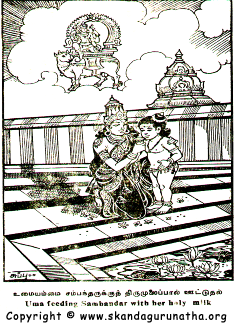 Lord Thoniappar (Siva) wanted to bless the child. So, He appeared with Mother Parvathi and asked Her to feed the child with the milk of divine wisdom. To obtain Siva's grace and divine knowledge, the grace of the Mother is necessary. So, Mother Parvathi fondled with Sambanthar and suckled him with the milk of wisdom. From that moment, Sambanthar was known asAludaiya Pillayar or one who enjoys the protection of the Lord — and also as Thiru-jnana-sambandar as he attained divine wisdom through the grace of Lord Siva and Parvathi. From the moment he drank the milk of wisdom, Thiru-jnana-sambandar began to sing soul-stirring songs in praise of Lord Siva. The collection of these songs is called Thevaaram.
Lord Thoniappar (Siva) wanted to bless the child. So, He appeared with Mother Parvathi and asked Her to feed the child with the milk of divine wisdom. To obtain Siva's grace and divine knowledge, the grace of the Mother is necessary. So, Mother Parvathi fondled with Sambanthar and suckled him with the milk of wisdom. From that moment, Sambanthar was known asAludaiya Pillayar or one who enjoys the protection of the Lord — and also as Thiru-jnana-sambandar as he attained divine wisdom through the grace of Lord Siva and Parvathi. From the moment he drank the milk of wisdom, Thiru-jnana-sambandar began to sing soul-stirring songs in praise of Lord Siva. The collection of these songs is called Thevaaram.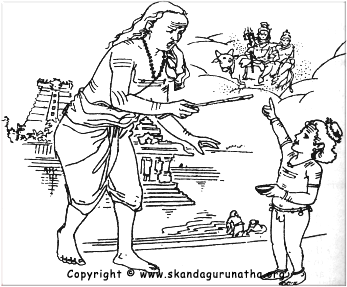
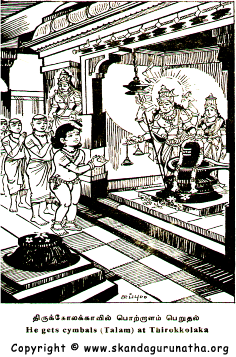 The next day Sambanthar went to Thirukkolakka and sang a song, clapping his hands to keep time. Lord Siva, pleased with this, presented Sambanthar with a pair of golden cymbals. Sambanthar, then, began to sing with the help of the golden cymbals. Even Narada and the celestials were charmed by this.
The next day Sambanthar went to Thirukkolakka and sang a song, clapping his hands to keep time. Lord Siva, pleased with this, presented Sambanthar with a pair of golden cymbals. Sambanthar, then, began to sing with the help of the golden cymbals. Even Narada and the celestials were charmed by this.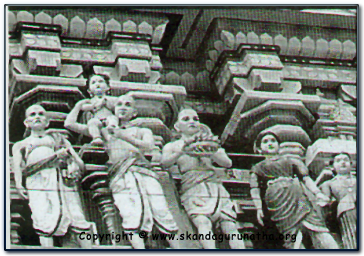
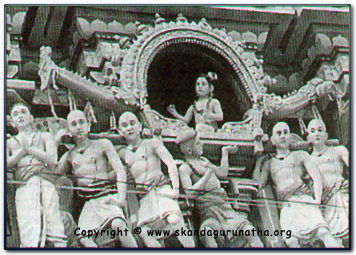

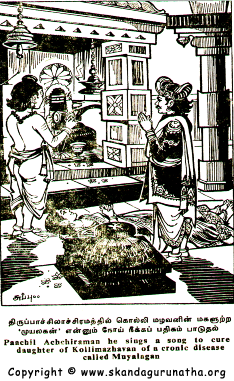 During the course of his pilgrimage, Sambanthar came to Thiru Pachilasramam. The daughter of the Malava King there, who was a great devotee of Lord Siva, was suffering from an incurable disease. The king, in despair, had taken her to the temple and placed her in front of the Lord. At the same time, Sambanthar had come into the temple. He saw the pitiable condition of the girl who was lying unconscious. He sang a Pathigam praying for Siva's grace upon the girl. She at once got up to the surprise of all. All were amazed at this miracle.
During the course of his pilgrimage, Sambanthar came to Thiru Pachilasramam. The daughter of the Malava King there, who was a great devotee of Lord Siva, was suffering from an incurable disease. The king, in despair, had taken her to the temple and placed her in front of the Lord. At the same time, Sambanthar had come into the temple. He saw the pitiable condition of the girl who was lying unconscious. He sang a Pathigam praying for Siva's grace upon the girl. She at once got up to the surprise of all. All were amazed at this miracle.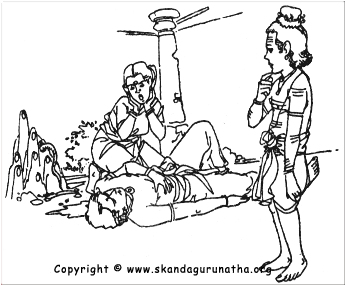
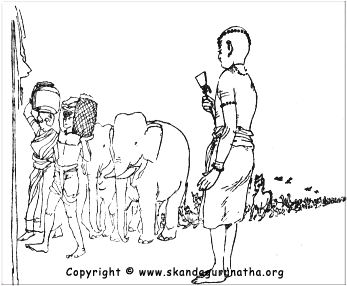
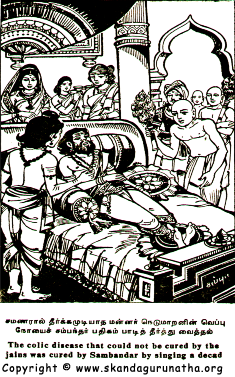 As soon as Sambanthar sang the pathigam, the fire in the camp died out and proceeded towards the king in the form of a dreadful disease. The king experienced a dreadful burning sensation all over his body. All the endeavours of the doctors and the Jain priests to alleviate the king's suffering proved futile.
As soon as Sambanthar sang the pathigam, the fire in the camp died out and proceeded towards the king in the form of a dreadful disease. The king experienced a dreadful burning sensation all over his body. All the endeavours of the doctors and the Jain priests to alleviate the king's suffering proved futile.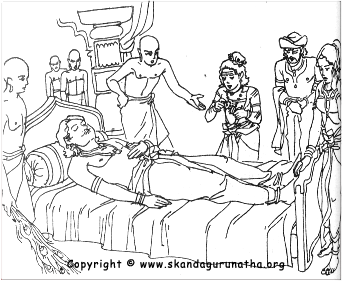
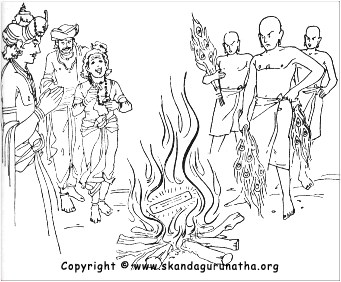
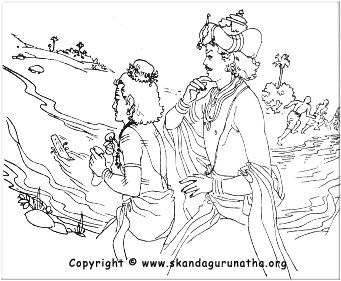
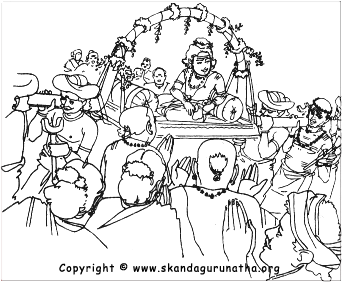
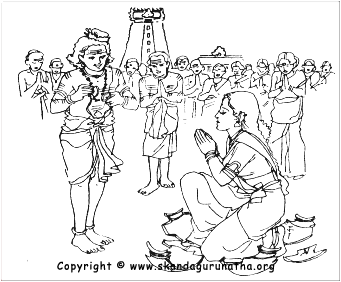
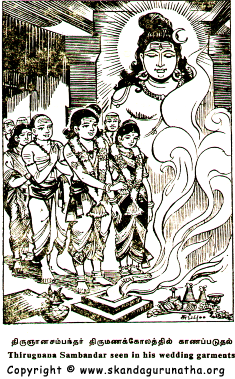 Sambanthar came to the place where the wedding was to take place. Sambanthar holding his wife's hand, went round the sacrificial fire (the manifestation of the Lord). Accompanied by the other Siva devotees, the couple went into the temple and worshipped Siva with total self-surrender. Sambanthar sang a pathigam praying for liberation. The Lord granted his wish and said, "Oh Sambanthar, you, your wife, and all those who witnessed your marriage will merge in the Siva Jyoti and come to me."
Sambanthar came to the place where the wedding was to take place. Sambanthar holding his wife's hand, went round the sacrificial fire (the manifestation of the Lord). Accompanied by the other Siva devotees, the couple went into the temple and worshipped Siva with total self-surrender. Sambanthar sang a pathigam praying for liberation. The Lord granted his wish and said, "Oh Sambanthar, you, your wife, and all those who witnessed your marriage will merge in the Siva Jyoti and come to me."
No comments:
Post a Comment